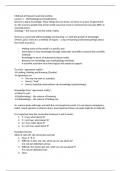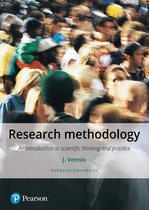Methods of Research and Intervention
Lecture 1 – Methodological considerations
Science is about knowledge. Many things that we know, we know on a base of agreement.
So, the way two people look at the world may have much in common but may also differ at
essential points.
Ontology = the way we see the world, reality.
Science is concerned with knowledge and learning, i.e. with the growth of knowledge
(Vennis, p25). Science is a method of inquiry – a way of learning and knowing things about
the world around us.
- Making sense of the world in a specific way.
- Generation of new knowledge through systematic (scientific) research (the scientific
method).
- Knowledge in terms of statements about reality.
- Research for knowledge uses methodology/methods.
- A scientific assertion must have logical and empirical support.
To reach “agreement reality”:
Looking, thinking and knowing (Goethe)
Agreement on:
The way we work as scientists
How to “look”
How to translate observations into knowledge (epistemology)
Knowledge from “agreement reality”:
What is real?
Epistemology – the science of knowing.
Methodology – the science of finding out.
So, science deals with logic and with the real (empirical) world. It is not about metaphysics,
belief, moral opinions or ethical values, how important those concepts might be in daily life.
It is important how the connection between P and Q works.
1. P = true; what about Q?
2. P = not true; what about Q?
3. Q = true; what about P?
4. Q = not true; what about P?
Example (Vennix)
When it rains (P), the street gets wet (Q).
1. Clear, P Q
2. Difficult, it does not rain, what can we say about Q?
Q is not per definition untrue.
3. Difficult, the streets get wet, what can we say about P?
P is not per definition true.
4. Clear.
,Shortcomings of human inquiry in general: (Vennix, p52)
- Inaccurate observations (visual puzzles)
- Overgeneralizations (“all… are…”), “Fooled by Randomness”
- Selective perception/observation (seeing what you expect to see, common patterns)
- Confirmation bias (looking for proof, dismissing other information)
- Illogical reasoning (“the exception that proves the rule”, gambler’s fallacy, logical
puzzles)
In management journals you can find the concept of “resistance to change”:
Employees in general don’t like change.
Gradually we find out:
Resistance to change is high when employees find out that the change-agents
don’t have a clear view on the existing problems.
And when the change-agents come up with incomplete or contra-productive
solutions.
Authority and tradition
- Both may be helpful or a hindrance for scientific work.
- Authority might help to steer your research in the right direction, but also hinder you
to develop your own ideas.
- Tradition is helpful to stand your ground as the public opinion does not agree with
your ideas or way of working, but tradition might hinder your work because of
promoting no-go areas for research.
Summary
1. Science is a method of inquiry – a way of learning and knowing things about the
world around us.
2. Logic provides a way to reason with knowledge.
3. Critical thinking and questioning are essential, to spot and counter biases and
develop our knowledge.
The two foundations of science are observation and logic.
Ockham’s razor = a principle of theory construction or evaluation according to which, other
things equal, explanations that posit fewer entities, or fewer kinds of entities, are to be
preferred to explanations that posit more.
Selecting the most appropriate hypothesis in abduction.
Parsimoniousness = it should use as little concepts as possible and it should have a large
scope.
,Chapter 4 – Quantitative research: Background
Empirical research = research in which observations are made and/or used (in other words,
research where data is collected and/or used). On the basis of the data collected, one or
more statements can be made, or conclusions can be drawn.
The empirical research process (Babbie, 1995) Page 75
All inductive sciences start with observation, try to find regularities and laws, produce
hypotheses to explain these laws (abduction), and then in order to test the laws and
theories, deduce hypotheses (as consequence from the theory), and test these by means of
new observations.
Observation
In the English literature the term observation is often employed in contrast with experiment.
Observation means the (inductive) study of phenomena, without interfering with them. It is
observation of phenomena in their natural setting.
Experiment
Experiment stands for an artificially created situation by a researcher in which (s)he studies a
particular phenomenon, a so-called test setup.
Why would one want to create an artificial situation, when one can study a phenomenon in
a real, natural setting?
Not all situations can necessarily be observed in a natural setting.
You don’t want to wait until you, accidentally, ran into a situation that is your experiment.
Advantages of experiments:
The researcher can create the phenomenon to be studied.
The researcher can control the situation in terms of other factors which may
affect/distort the measurements.
Testing
The process of testing a theory, starts with formulating hypotheses as consequences of a
theory. The first step is to deduce logical consequences from the hypothesis/theory, i.e.
predictions what would be expected in empirical reality if the hypothesis is correct.
Setting | Purpose Exploration, finding Testing of hypotheses
regularities (induction) (deduction from theory)
Natural - Kepler’s laws - Finding the planet
- Janis’ groupthink Neptune
- Festinger: when
prophecy fails
Created (experiment) - Newton’s prism - Galilei: law of falling
- Biases and heuristics bodies
- Pascal: test Torricelli
barometer
, Theoretical statements (hypotheses) are converted into a plan for making empirical
observations (gathering relevant empirical evidence). The evidence collected should provide
a conclusive answer as to whether those theoretical statements are true.
The research process always begins by checking whether theories are already available.
Without theoretical concepts, it is not possible to interpret the collected empirical data
accurately. The second step is to create a conceptual model. In addition to a clear
description or explanation, this will often take the form of an (arrow) diagram. This
conceptual model serves as a guideline for the subsequent research. It is tested against
reality by collecting data (making observations).
1) An operational definition is needed of the units of analysis, clarifying who does and
does not belong to the target group for research.
2) The concepts, the characteristics attributed to the units of analysis, from the
conceptual model, need to be operationalized. They must be translated into
measurable variables.
3) An analytical model for the data to be collected is defined:
a. The research relates to a causal relationship.
b. The research relates to a relationship between specific phenomena.
c. The conceptual model relates to differences between groups or situations.
Research design = a plan for collecting and analyzing evidence that will make it possible for
the investigator to answer whatever questions he or she has posed.
1) Experiment
2) Survey
3) Case study
Both experiments and surveys can be seen as ‘static’ research designs. They do not really
focus specifically on changes or processes. Case studies by contrast focus specifically on this.
Researchers, here, are concerned with patterns and processes, and therefore changes over
time.
Experiments + surveys Empirical-analytical research tradition
Case study Qualitative research
Experiment
A laboratory experiment is ideally suited for research into causality. It is the only design
which, if set up correctly, can provide a conclusive answer about the causal effect of one





